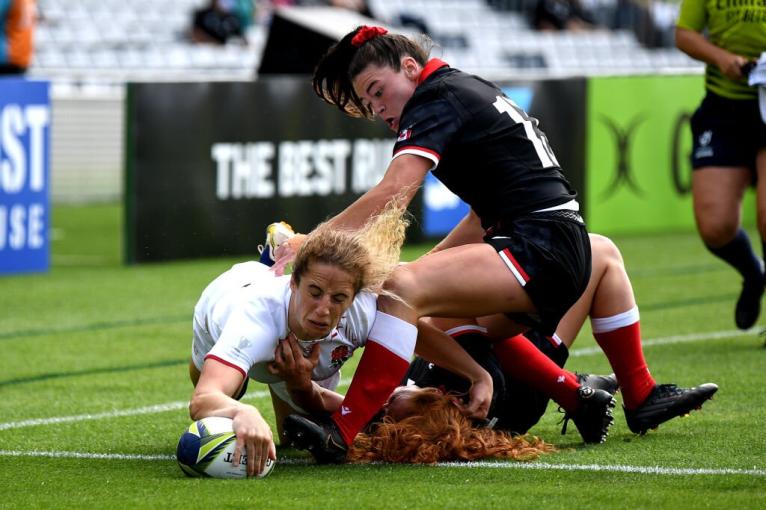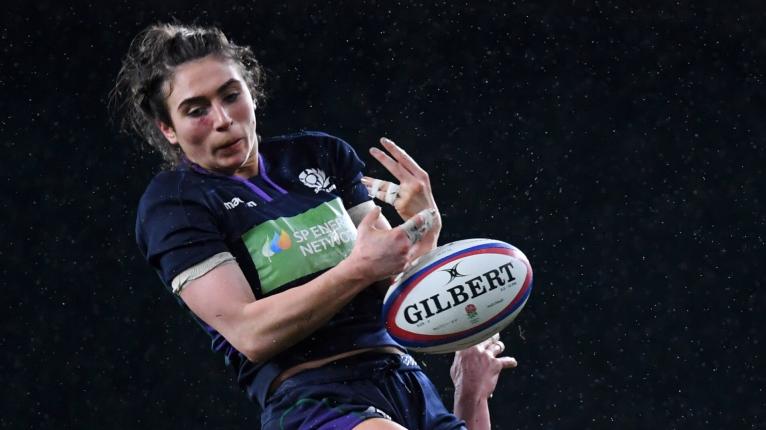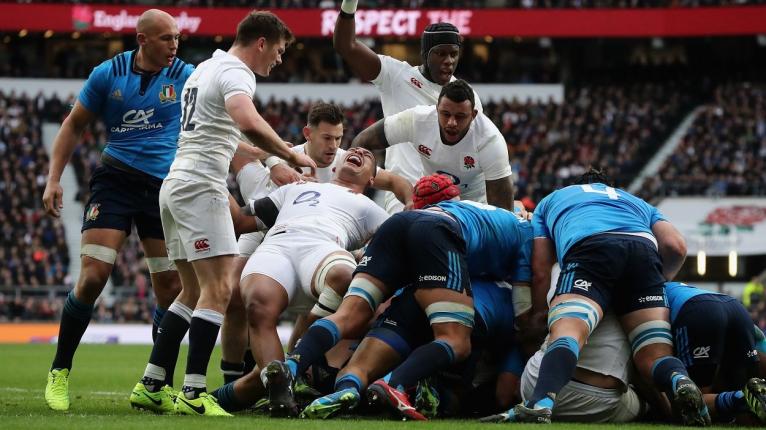At a recent Shape of the Game conference, all rugby stakeholders in the men’s XV game discussed ways of speeding up the game, getting the ball in play more and creating a safe and entertaining spectacle.
Now, with Rugby World Cup 2023 on the horizon, World Rugby has brought several Law Application Guidelines forward for implementation in the elite game. These changes took effect from 1 January, 2023, meaning they will be applied during the upcoming Six Nations Championship.
Ahead of the competition, referee Matthew Carley unpacks what these new Law Application Guidelines will mean for fans, players and referees, while referee Angus Gardner has explained some of the more complex and misunderstood current laws to fans.
So, let’s review their comments in detail and take a look at the changes you can expect to see in the Six Nations and beyond.
How will referees manage the scrum and lineout?
One area of the game where the new Law Application Guidelines will be particularly relevant is during scrums and lineouts.
As a result of the new guidelines, Matthew Carley believes that fans will no longer see players milling around waiting for a scrum. Instead, these spectators will regularly hear referees encourage players to form the scrum quickly.
This is a point emphasised in World Rugby’s ‘speeding up the game’ guidelines, which state that a free-kick should be given if a team is not ready to form a scrum within 30 seconds of the mark being made.
However, although forming the scrum quickly will help speed up the game and increase fan entertainment, Matthew Carley has also stressed that referees must continue to see player safety as paramount. As a result, he believes referees must ensure the players are comfortable before the scrum is formed.
While speaking about the new guidelines, referee Angus Gardner was sure to inform fans of exactly what he’s looking for in a scrum. He jokingly commented that “ball in, ball out” was the number one priority.
For this to happen regularly, he said that he looks for “a stable platform between the two teams”, as well as a “safe engagement process”. In addition, on the hit, both teams must be “still and stable” with “a forward pushing contest from both”.
In addition, Matthew Carley stated that lineouts are one area of the game where the new regulations will help referees gain some time back. He thinks that referees should prevent sides from huddling and should instead ensure that the lineout is formed quickly. This is a point that’s emphasised in World Rugby’s Law Application Guidelines, which state that a free-kick should be given if one team delays a lineout.
How do referees view advantage?
Angus Gardner believes that referees must look at two things when it comes to advantage: territorial advantage and tactical advantage.
When considering territorial advantage, he says that referees must decide whether the team has either gained field position or territory on the pitch that will allow them to take advantage of the opportunity.
He then added that the referee must also decide whether a team has gained a tactical advantage, such as a space to play. For example, if there has been a knock-on, the referee must consider whether the team has clear space to recycle the ball and move forwards across the advantage line.
How do referees manage TMO assistance?
The TMO (television match official) plays a vital role in ensuring the referee makes the correct calls and does not miss any incidents that need to be penalised. However, although TMOs are incredibly useful, some rugby fans have concerns that TMO reviews take too long.
Due to this, some adjustments have been made to the TMO protocol. Now, World Rugby has reminded match officials that “the current TMO protocol is aimed at identifying and ensuring clear and obvious offences are dealt with on-field.” The governing body has added that referees should “limit replays where not necessary”.
Matthew Carley has said that TMOs are now being encouraged to tell the referee when they’ve spotted a penalty-only foul play offence. This means the referee can play advantage and does not necessarily need to go to the screen to officially review the situation.
He also stated that referees and TMOs have worked hard to gain clarity around the head contact rule so the whole TMO process can be more streamlined. However, he went on to clarify that player safety and getting the correct outcome remain vital.
Ultimately, although referees are trying to shorten the time it takes to make a decision with TMO assistance, they will still take their time when required. But, Matthew Carley added that “hopefully that is less apparent than what we’ve seen in the past.”
He hopes that by encouraging the TMOs to be confident in what they’ve seen and empowering them to relay that information to a referee before an incident is shown on the screen, referees can make a decision within two to three replays.
How do referees determine grounding?
Angus Gardner has stressed that there are a couple of things that each referee looks at in relation to grounding.
For example, if the ball is already on the ground in the in-goal area, then all a referee is looking for the attacker to do is press the ball down.

Meanwhile, if an attacking ball carrier is in possession of the ball, a referee must look to make sure that there has been no separation between the ball and the player (such as the player dropping the ball). They must also make sure the player presses the ball into the turf.
How do referees manage deliberate knock-ons?
A knock-on occurs when a player knocks the ball forwards (just as the name suggests). Knock-ons usually happen accidentally when a player is either in possession or is attempting to catch the ball from a teammate. They can also occur when an attacker drops the ball over the try line under pressure or when a player is tackled.
However, on occasion a referee may determine that a player has purposefully knocked the ball on. This is known as a deliberate knock-on and it most commonly occurs when a defender makes an attempt to intercept a pass. In these situations, the player makes it look as though they’re trying to catch the ball but they actually just bat the ball down in order to stop a near-certain try or an overlap. Here, we should clarify that charge-downs are not considered as knock-ons.

Matthew Carley believes the new regulations will lead to a slight shift in what referees are looking for when it comes to deciding whether a player has committed a knock-on or a deliberate knock-on.
He said that although the deliberate bat of a ball forwards is quite an obvious action to spot, referees are now beginning to consider how much time and space a player has when they’re looking to intercept a ball. This means that if a player knocks the ball on while attempting to intercept it with one hand, this doesn’t automatically mean that a referee will rule that there has been a deliberate knock-on.
Instead, in these situations, a referee must assess whether the player was making a genuine attempt to catch the ball. If the player has time and space, has read the game well and is making an attempt to catch the ball (even if that attempt only utilises one hand), then the referee may decide that there has been a knock-on rather than a deliberate knock-on.
By contrast, if the player is operating in a confined space, doesn’t read the play and makes a batting motion with either one or both hands, then the referee is more likely to rule a deliberate knock-on has occurred because the player has not made a genuine attempt to catch the ball.
How will the jackler be managed in the ruck?
Let’s start with the basics here. The jackler is the first arriving team-mate of the tackler at the tackle, or the first person to get to an isolated ball carrier who is on the ground.
As this player has such a vital role, there are clear rules that state how a jackler must act in the ruck. For example, the law currently states that a jackler must remain on their feet and contest for the ball directly. If this player was initially involved in making the tackle, then the jackler must first release the ball carrier before they try to take the ball off the attacker.
Throughout any attempt to take the ball, the rules state that the jackler must support their own body weight. Any attempt to go to ground and reset must be penalised.

Matthew Carley says that the main thing he looks for with the jackler is “hands on the floor”. He explained that all referees want the jackler to support his or her bodyweight. By contrast, if the jackler’s hands are on the floor, then this may suggest to the referee that this player has gone past the ball. As a result, they’re no longer in control of the situation.
However, Mr Carley did clarify that there are occasions where the jackler may be allowed to place their hands on the floor and search for the ball, such as when the ball carrier has trapped the ball with their body.
That said, he reiterated that if the jackler is leaning with their weight through their hands or they’re waiting for the clear out to push them back onto the ball, the referee should penalise that action.
World Rugby’s new definitions emphasise this point and state that all players who put their hands on the floor at tackles, rucks and mauls are subject to sanction. However, judgement can still be used by a referee if the player is using the ground briefly to maintain their own balance and stability.
What are the current head contact processes?
If one player makes contact with the head of another, Angus Gardner believes that referees must follow a set process:
The referee must determine whether there has actually been head contact
The referee must work out whether there has been foul play
The referee must ascertain the level of danger (high or low)
The referee must look for any mitigating circumstances
Using this four-step process, referees can make accurate and well-informed decisions regarding the punishment required.
































Comments on RugbyPass
You ask good questions, Nick. The group who have put together the proposal to play out of Tarneit and participate in the growing of the ground’s capacity are not a bunch of white knights who have been dragged in post-crisis; they were around whilst the Rebels accummulated $23m in debt. Why do we come up with ideas that might make the franchise affordable after it’s broke and not when it might have prevented the trainwreck this offseason was? As for Gordon/Kellaway v Lolesio/Wright, they are both good options. I think the former are better rugby players but the goal kicking of Noah may be decisive when Schmiddy makes his choices. I know Harry Jones has the hots for Edmed but I think it’s one of his few poor choices and he and Jorgensen aren’t close to the other pairs. By coincidence, the wife and I went into town over the weekend to watch Brian Cox and Patricia Clarkson in Long Day’s Journey into Night. Beautifully acted but it was 3.5 hours in the chair and very hard work. Like the Rebels, there were only small bursts of joy to go with a lot of bad news and a depressing story line. In the end, I was hoping it would end and I could give my sore butt a break. Again, familiar.
32 Go to commentsGood decision, very good player but not international quality. But so was Jamison Gibson Park …..
3 Go to commentsLoose forwards always look good going forward and winning. It’s the same loose forwards for the Crusaders and the Canes this year as last year. Too much of the shiny new things getting noticed here while older consistent ones getting bagged. It’s early days. Calm the farm.
5 Go to commentsThanks Nick, and on the money. We tend to be apathetic until something REALLY BAD happens, then we aren't! At least this applies to the Reb players and coach, if not the spectators. They seem to be getting very quick ball at times. Have they altered something, or is it just all of the skills coming together at the right time? It seems almost the opposite of the Reds, who started the season with quick ball, but haven't been showing that in the last 3 losing games. Is it attitude (McDermott hasn't looked “right” to me for 3 weeks), or something else?
32 Go to commentsGood summary. As said, Sevu Reece has been electrifying for the Crusaders. Great try and he has been everywhere. Amazing he is now equal with Caleb Ralph , club record of 52 tries for the Crusaders. That record beckons. Good to see Dallas McLeod getting regular starts at last. A big few weeks are ahead.
5 Go to commentsGood article/interview.As was said Christian Lio-Willie was barnstorming when he came on for the Crusaders. What happened at the end, self-explanatory.Captain fantastic Scott Barrett is due back soon as well, once they are back from Aussie. Great to see Ethan Blackadder back last week.
1 Go to commentsYou must have been watching one team, Andrew - and even then you missed the brightest star in the Chiefs pack - Naitoa Ah Kuoi, 2 turnovers, genuine line-out presence and grunt around the field, and the soft hands of a back.
5 Go to commentsHaha what a crock of sh!t these headlines are. Moorby’s best year was that first. Still doesn’t seem to have the same game about him as when he was fresh but has bounced back well this season to be playing consistent tight accurate footy
3 Go to commentsIt’s even dumber than Bernard Foley not kicking the penalty to touch in the Melbourne Bledisloe in 2022.
3 Go to commentsYes, they are traveling well but it’s early days. The Chiefs were in front with 20 to go while they snatched a last minute win v the Reds. Keep calm.
1 Go to commentsThe failure of the Irish system / rugby playing style to produce their own backs has them looking elsewhere for innovation and flair - not that Jordie has much flair. He’s a converted fullback. The Canes have plenty of other younger options.
9 Go to comments1.Watch Wallace Sititi be the wild card AB. A genuine full time no 8 2. Luke J like Sotutu has not delivered. 3. Chiefs have all the right cattle but badly miss the leadership of Webber. LJ is about as unconvincing as Sam Cane when under the pump. They had the winning of that game in the second half then fell apart.
5 Go to commentsYes the Rebels are showing signs of life because they are literally playing for their live -lihoods and thanks to their Australian attack coach. However they are still playing an essentially dull boring south african style for the rest of the time. And Geoff Parling must be the most useless lineout coach ever. Worse than Steve Hansen even. Interestingly we are starting to see more cheap shots and attempts to get away with cheating by Australian players, now they are being influenced by Joe Schmidt. It was exactly the same when Rennie started out as Wallaby coach and thru his tenure. Trying to teach Australians to play like kiwis doesn’t work, as the last 20 years has conclusively demonstrated. Especially when we are not as good at it as kiwis. Which of course is the whole idea …..
32 Go to commentsGreat signing, not sure where he’ll fit in though. As for him ‘playing alongside RG Snyman, that’s highly debatable given the likelyhood that the latter will spend most of the season on sick leave.
9 Go to commentsWowee!
9 Go to commentsEvery team that has played a game in Africa this Champions Cup season is already out of the competition - including the SA teams. Could be a concidence.
30 Go to commentsthat should offer some experiences for Jordie.
9 Go to commentsJust remember: He is not a winger. Took Ian Foster 2 years to figure that out.
9 Go to commentsExcellent article, Nick. We (your RP colleague Brett McKay and my 8/9 Combo cohost), are going to have LSL on our podcast later this month. He has shown consistent excellence as a leader and lock. I’ll chat with you offline about a line of questioning if you have time. H
32 Go to commentsSo no Irish fan or journalist suggested JGP was as good as DuPont. Then even the guy who supposedly did is from Wales and said JGP would be the best around if it was t for DuPont. Right, so what is this story about again
19 Go to comments